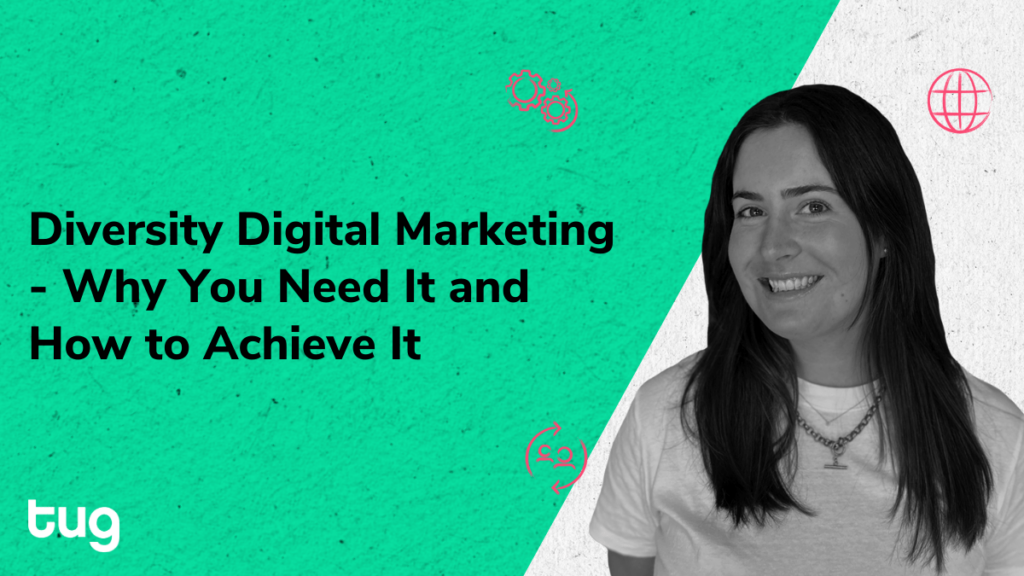
Diversity in Digital Marketing – Why You Need It and How to Achieve It
By Bella Backwell, Junior Copywriter at Tug Agency
It feels like pretty much everywhere we look we’re exposed to advertisements. On our phones, the television, buildings, public transport – you name it, there’s an ad on it. However, among all the many millions of messages we’re fed, what makes some advertisements stand out over others?
The makings of a memorable campaign start with creativity and relatability. Consumers are calling for authentic advertisements that can actually relate to the society they’re trying to speak to. According to the 2022 Consumer Equality Equation Report, 80% of respondents said that brands have a responsibility to reflect modern Britain. Prioritising inclusivity in advertising campaigns by highlighting underrepresented groups can go a long way in achieving this.
Minority Groups in Marketing
In recent years, many brands and marketing agencies have taken strides to become more inclusive in their campaigns. However, there’s still a long way to go in creating advertisements that more accurately reflect the population.
A recent study commissioned by Karmarama and conducted by YouGov surveyed more than 6,500 consumers in the UK. It found that only 36% of LGBTQIA+ respondents felt that advertisements truly reflected their community. The representation gap that exists in advertising means that minority groups – such as people with disabilities, ethnically diverse people, and members of the LGBTQIA+ community – are constantly being overlooked and underrepresented in marketing campaigns.
The exclusion of these groups in advertisements can also result in brands inadvertently closing themselves off to a whole section of potential customers. Now more than ever, people are eager to support brands that align with their values. The 2021 Kantar Global MONITOR Study showed that 59% of consumers feel it’s important to buy from companies that actively promote diversity and inclusion.
Representation Resonates with Consumers
Marketing campaigns have the power to both reflect and affect today’s culture. As such, advertisers have a duty to accurately portray the diversity of society, and this resonates with consumers too.
The 2022 Consumer Equality Equation Report showed that 84% of respondents across all ethnic groups agreed that it’s important for brands to promote diversity and inclusion.
The creation of diverse campaigns also has benefits that feed back into marketing agencies. If an advertisement encompasses a wider proportion of society, they may find that a larger amount of people relate to it.
Put simply: representation resonates. But, it’s not enough to just put out inclusive marketing messages – it needs to be authentic to be inspiring. Inclusivity is not a box to check, it’s something that companies should integrate both in their ads and internally in their workforce.
How Can Brands be More Inclusive Internally?
There’s so much more the UK marketing and advertising industries can do to better their internal inclusivity. The 2023 All In Census, which is the only industry-wide survey in UK advertising, showed that there is still a huge lack of representation of minority groups. It reported that only 1% of people in these industries identified as non-binary, and 0.3% were transgender. In addition, LGBTQIA+ representation in C-Suite roles is only 7% nationwide.
Advocacy group Outvertising recently visited Tug Agency to teach us more about the current state of LBGTQIA+ inclusion in the UK marketing industry. Their mission is to provide support for organisations in their internal efforts to become completely inclusive in their workplaces and communications.
Their talk provided us with insights on how brands and agencies can create more inclusive campaigns. It’s crucial that authenticity is at the heart of every advertisement for it to resonate with consumers. To achieve this, brands and agencies need to ensure they are internally prioritising diversity as well as externally promoting it. This can be done by creating an inclusive culture and adopting hiring practices that are supportive of minority groups.
This is important in shaping the perception of a company from a consumer and employee’s point of view. Hannah Thompson, head of the DEI Steering Committee at Tug Agency, says “we’re hearing more and more that people want to work on brands and at agencies that they care about and that they feel represents them and their values.”
Brands also need to ensure that the audience they’re trying to reach is not limited to certain demographics. Hannah stresses the importance of inclusive ad targeting for marketing agencies. “It’s important that we make sure our targeting is inclusive so that we don’t miss out on audiences because of our biased understanding of who an audience is,” she adds.
Here are some of Hannah’s key takeaway tips for companies looking toward a more inclusive future:
- Audit your processes – what negative targeting are you using?
- Question everything – what’s the demographic makeup of your top audiences? Are you missing opportunities by assuming your audience? AI is a great one for this – don’t blindly start using it without questioning the data it’s using.
- Work closely with creative teams to incorporate inclusivity into the creative assets.
Prioritising diversity in marketing campaigns should be at the forefront of every agency’s mission going forward. Consumers expect more from advertisements – they want authentic and accurate representation. Harnessing this power is crucial to creating successful campaigns that resonate with and inspire consumers.


